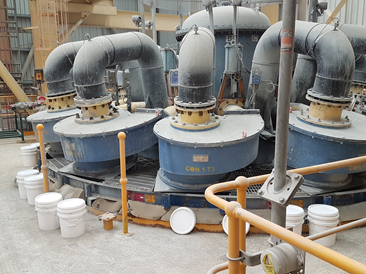 Results of Newcrest funded PhD research conducted by Juan José Frausto González that aims to better understand the impacts of the poor classification efficiency of hydrocyclones on the performance of grinding and flotation circuits
Results of Newcrest funded PhD research conducted by Juan José Frausto González that aims to better understand the impacts of the poor classification efficiency of hydrocyclones on the performance of grinding and flotation circuitsKey learnings
- Poor hydrocyclone efficiency results in unnecessary recycle of fines to underflow, reducing ball mill circuit capacity.
- Hydrocyclones allow bypass of poorly liberated coarse composites to flotation, reducing flotation recoveries.
- By replacing hydrocyclones with screens, in a lead zinc operation, classification efficiency was improved resulting in a 20% increase in throughput and 6% increase in flotation recovery.
- Hybrid classification and semi inverted (SIV) hydrocyclones are alternative methods of improving classification which are easier to implement & operate than screening
Introduction
The process linking comminution with flotation is the size classification. It determines which particles are diverted back for additional grinding and which pass to downstream flotation. Hydrocyclones and screens are the most commonly used size classification units in the mining industry. Hydrocyclones do have some major advantages such as robustness, relatively small footprint for a high capacity and comparatively low maintenance, capital, and operating cost. They are, however, associated with some problems and classification efficiency can be poor, especially when one is trying to achieve a coarse cut size.
A typical classification efficiency curve of a hydrocyclone, as compared to a perfect separator, is shown in Figure 1. Poor separation efficiency in a cyclone is caused by:
- A high proportion of water in the feed bypasses to the underflow and this brings with it fines which should report to the overflow. Typical water recovery to underflow in a cyclone is 30 to 40%.
- Cyclones are a hydraulic classifier, where separation is not only based on size but on particle density. Mean performance is an average of a feed that actually contains different minerals with different degrees of liberation which have different density.
- To cut coarse, mining operations need to use large diameter hydrocyclones operating at high percentage of feed solids which are associated with poorer separation efficiencies.
Newcrest funded a PhD conducted by Juan José Frausto González (González, 2020) which aimed to better understand the impacts of the poor classification efficiency of hydrocyclones on the performance of grinding and flotation circuits. His project involved performing surveys of the hydrocyclones at Cadia and a comparison of hydrocyclones and screens at Minera Saucito’s lead zinc operation in Mexico.

